How to Set a Table
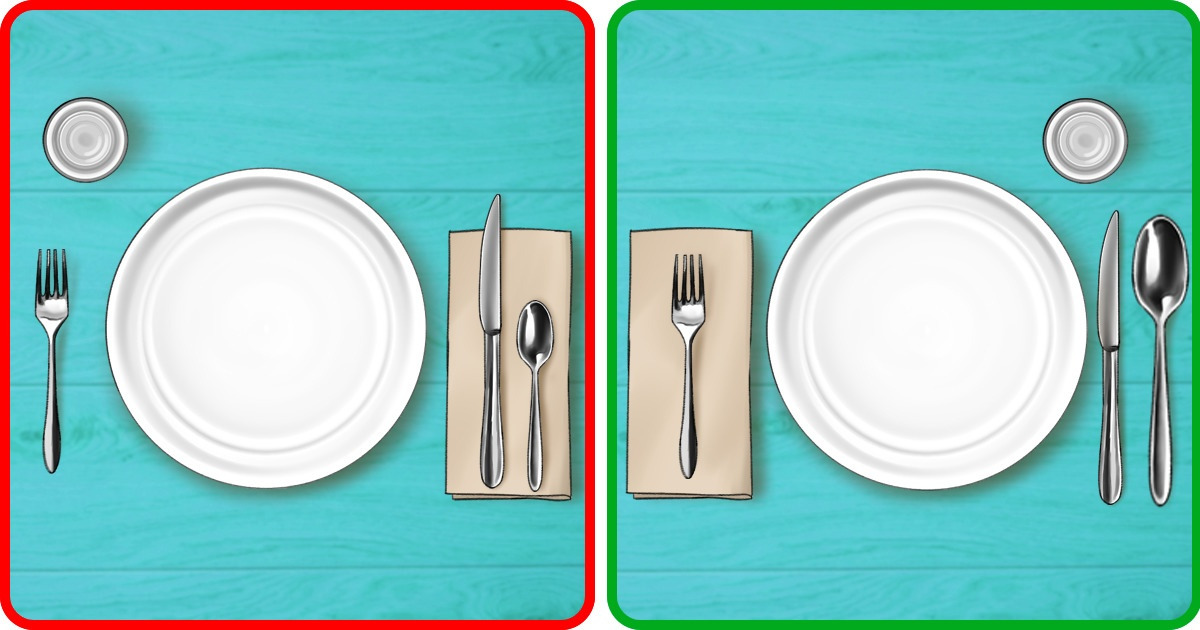
Setting a table is an important part of any good dinner. When a table is set well, it makes us want to eat more, and it’s an indicator that the host is paying special attention to everyone in the room.
5-Minute Crafts offers instructions on how to properly set a table depending on the occasion.
Decorations
In the center of the table, you can put the main decoration. It can be a vase of flowers, for instance.
After that, you can put down placemats that show the guests where they are supposed to sit.
Next, you put down ordinary napkins, plates, and utensils.
Basic table setting
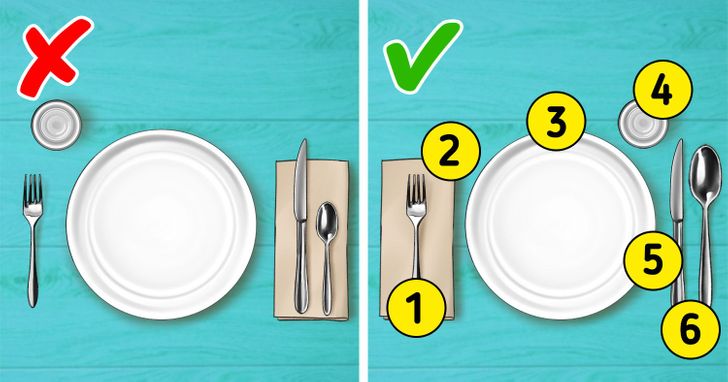
1 — dinner fork; 2 — napkin; 3 — dinner plate; 4 — water glass; 5 — knife; 6 — spoon
This type of setting is great for a regular lunch or dinner. It requires a minimum of dishes and utensils. This is what you should do:
-
Lay the placemat on the table.
-
Put the dinner plate in the middle of the placemat.
-
To the right of the plate, place the knife closest to the plate, blade pointing inward. Place the spoon to the right of the knife.
-
Place the water glass slightly above the plate, in between the plate and the utensils, about where 1 p.m. would be on a clock face.
Casual table setting
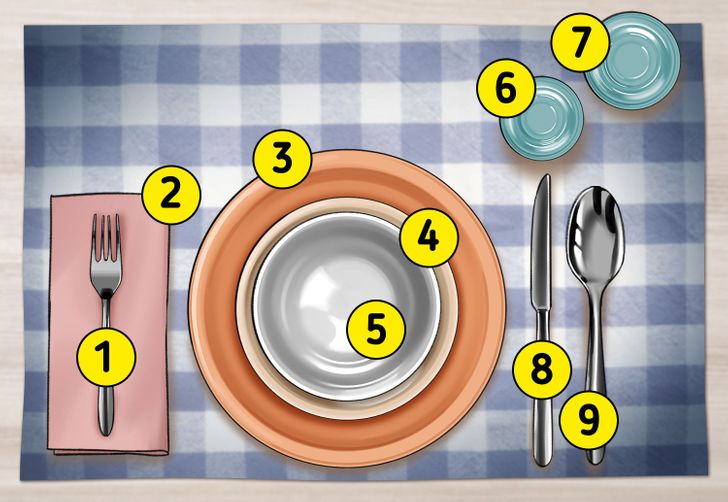
1 — dinner fork; 2 — napkin; 3 — dinner plate; 4 — salad plate; 5 — soup bowl; 6 — water glass; 7 — glass for other drinks; 8 — dinner knife; 9 — spoon
If you want to make a regular dinner a little bit more formal, or if you invite guests over, you can use this type of setting. The table should only have the dishes and utensils that will be used by the guests.
This is how you should set the table:
-
Lay the placemat on the table.
-
Put the dinner plate in the middle of the placemat. Place the salad plate on top of the dinner plate. If you’re starting with a soup course, place the soup bowl on top of the salad plate.
-
To the left of the plate, place the fork on the napkin. To the right of the plate, place the knife closest to the plate, then the spoon.
-
Directly above the knife, place the water glass. To the right and slightly above the water glass, place a glass for another beverage.
Important: If you’re serving steak, it’s better to replace a regular knife with a serrated knife to be able to cut the meat easily.
Full table setting
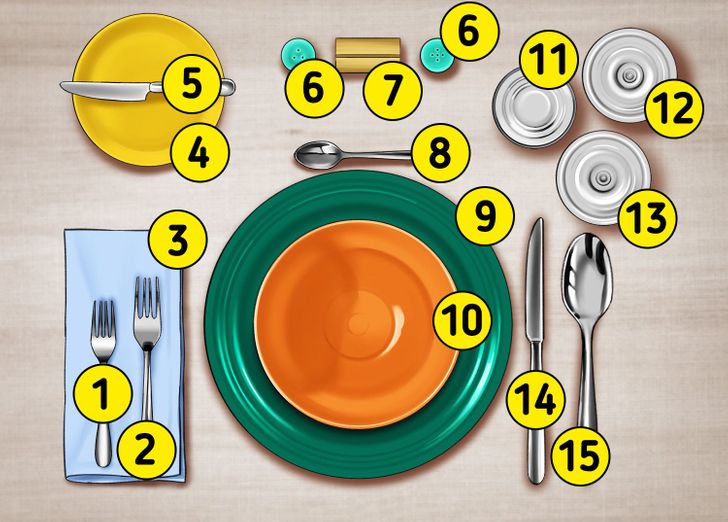
1 — salad fork; 2 — dinner fork; 3 — napkin; 4 — bread plate; 5 — butter knife; 6 — salt and pepper shakers; 7 — place card; 8 — dessert spoon; 9 — charger; 10 — soup bowl; 11 — water glass; 12 and 13 — other beverages; 14 — knife; 15 — spoon
This type of setting is used for official receptions, dinners, and lunches in a formal environment. There should be at least 3 different courses. This is how it’s done:
-
Lay an ironed tablecloth on the table.
-
Set a charger at each seat.
-
In the center of the charger, place a soup bowl.
-
Place the bread plate to the top left of the charger. And on the plate, there should be a butter knife.
-
To the left of the charger, place the salad fork on the outside, then the dinner fork on the inside.
-
To the right of the charger, place the knife closest to the charger, then the soup spoon.
-
Directly above the charger, place a dessert spoon.
-
To the right of the water glass, place the white glass for different beverages. Since people traditionally drink more water than anything else during dinner, the water is kept closer to the diner.
-
If using a place card, set it above the dessert spoon.
Depending on the meal, the dishes and the utensils may vary.
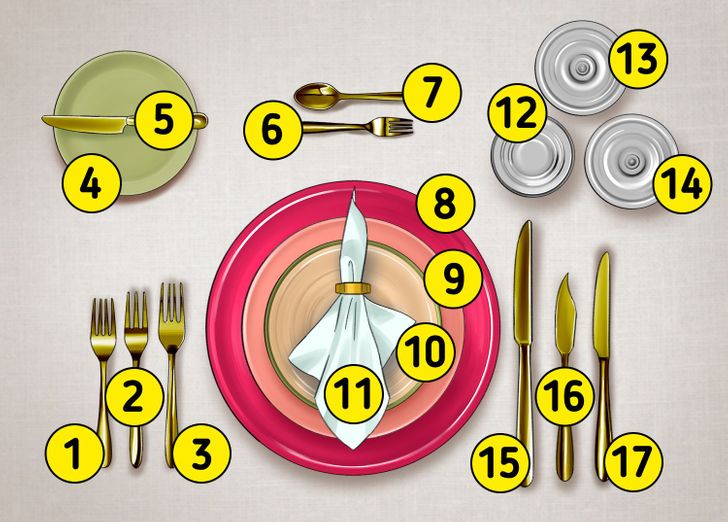
1 — salad fork; 2 — fish fork; 3 — dinner fork; 4 — bread plate; 5 — butter knife; 6 — dessert fork; 7 — dessert spoon; 8 — charger; 9 — plate; 10 — salad plate; 11 — napkin; 12 — water glass; 13 and 14 — glasses for other drinks; 15 — dinner knife; 16 — fish knife; 17 — appetizer knife
When you’re serving fish, for example, you should add special forks and knives for it. If there are 3 kinds of forks on the left of the charger, it’s better to place the napkin on the plate.
Sometimes, the choice of utensils is determined by how comfortable it is eat to the meal. For example, some desserts are better eaten with a dessert fork. But if you’re eating grapes, you also need a dessert knife to be able to cut every grape and take out the seeds.
Breakfast
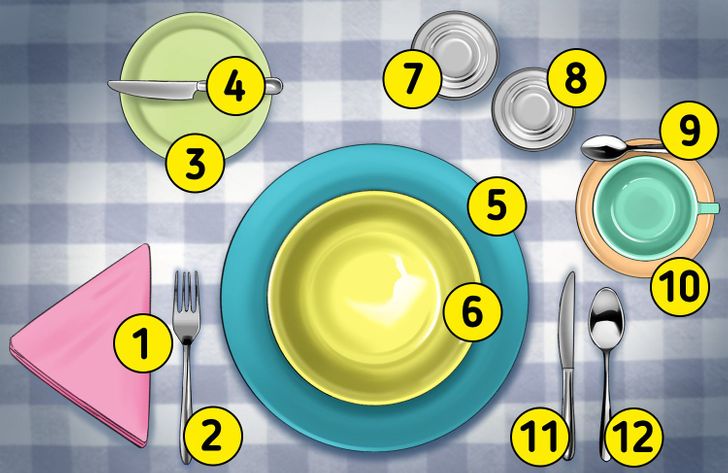
1 — napkin; 2 — dinner fork; 3 — bread plate; 4 — butter knife; 5 — charger; 6 — deep bowl; 7 — juice glass; 8 — water glass; 9 — teaspoon; 10 — cup; 11 — dinner knife; 12 — dessert spoon
If you’re setting a table for breakfast, on the right of the utensils, you should put a cup of tea or coffee. Above that, you can put the water glass and juice glass. In the center of the dinner plate, put down the porridge plate, and in the top left corner, you put the bread plate and butter knife. On the left of the plate, there should be a napkin and a fork.
Kinds of plates
-
Dinner plates are used for the main course. The average dinner plate measures at around 10.5 in (27 cm) across. This plate is the most used plate during the entire meal and usually comes out after the salad. It’s the plate resting right on top of the charger.
-
Dessert plates are usually used at formal and informal banquets. You can use it for snacks, appetizers, and desserts. This plate is only about 7 in (18 cm) in diameter. It’s also often used at parties, weddings, and more.
-
Bread and butter plates are usually placed next to the fork. Bread and butter plates are round like most other plates. The difference is that it has a small size, which is about 6 in (15 cm) in diameter.
-
Soup plates/bowls are deep because they’re for liquids.
-
Salad bowls are usually round, about 8.5 in (22 cm) in diameter.
-
Appetizer plates are available in sizes that are quite diverse. Big ones are set on larger tables, while smaller ones are for individual use. Appetizer plates are like bread plates but bigger. Fruit and cheese can be served on them.
-
Chargers are usually flat and 12 in to 14 in (30 cm to 35 cm) in diameter. Other plates are put on top of the chargers. Chargers are just a decoration, protecting the table and the napkins from food.
Also, there can be oval-shaped plates for fish, plates for fish appetizers and seafood, deep bowls for caviar, and a bowl of water with mint and lemon to wash the hands in if there are meals that are supposed to be eaten with the hands.